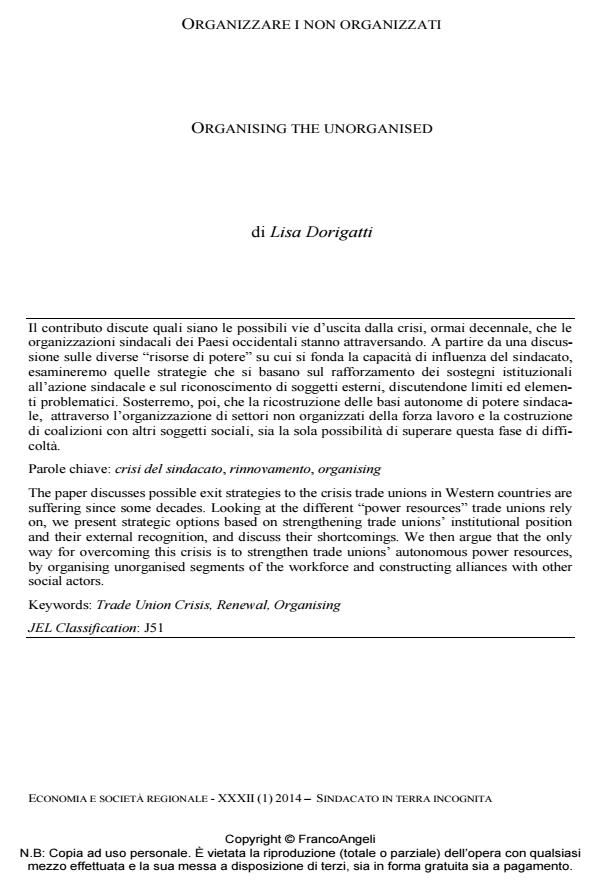Organising the unorganised
Journal title ECONOMIA E SOCIETÀ REGIONALE
Author/s Lisa Dorigatti
Publishing Year 2014 Issue 2014/1
Language Italian Pages 13 P. 129-141 File size 705 KB
DOI 10.3280/ES2014-001010
DOI is like a bar code for intellectual property: to have more infomation
click here
Below, you can see the article first page
If you want to buy this article in PDF format, you can do it, following the instructions to buy download credits

FrancoAngeli is member of Publishers International Linking Association, Inc (PILA), a not-for-profit association which run the CrossRef service enabling links to and from online scholarly content.
The paper discusses possible exit strategies to the crisis trade unions in Western countries are suffering since some decades. Looking at the different "power resources" trade unions rely on, we present strategic options based on strengthening trade unions’ institutional position and their external recognition, and discuss their shortcomings. We then argue that the only way for overcoming this crisis is to strengthen trade unions’ autonomous power resources, by organising unorganised segments of the workforce and constructing alliances with other social actors.
Keywords: Trade Union Crisis, Renewal, Organising
Jel codes: J51
- Baglioni G. (2008). L’accerchiamento. Perché si riduce la tutela sindacale tradizionale. Bologna: il Mulino.
- Baccaro L. (2009). Similar Structures, Different Outcomes: The Surprising Resilience of Corporatist Policy-Making in Europe. Paper presentato alla Conferenza SASE. Parigi, 16-18 luglio.
- Baccaro L. (2010). Does the global financial crisis mark a turning point for labour. Socio-Economic Review, 8(2): 341-347, DOI: 10.1093/ser/mwq001
- Baccaro L. (2013). “È possibile fermare il declino del sindacato?”. Intervento al Seminario C’è un futuro per il sindacato? Quale futuro?, Fondazione Claudio Sabattini. Roma, 5 aprile.
- Baccaro L., Hamann K. e Turner L. (2003). The Politics of Labor Movement Revitalization: The Need for a Revitalized Perspective. European Journal of Industrial Relations, 9(1): 119-133, DOI: 10.1177/0959680103009001455
- Crouch C. (1996). Relazioni industriali nella storia politica europea. Ediesse: Roma.
- Crouch C. (2012). Il potere dei giganti. Perché la crisi non ha sconfitto il neoliberismo. Bari: Laterza.
- Dörre K., Holst H. e Nachtwey O. (2009). Organizing: A Strategic Option for Trade Unions Renewal?, International Journal of Action Research, 5(1): 33-67.
- Fajertag G. e Pochet P. (1997). Social Pacts in Europe. Bruxelles: European Trade Union Institute and Observatoire social européen.
- Ferraris P. (1992). Domande di oggi al sindacalismo europeo dell’altro ieri. Quattro lezioni all’Università di Campinas. Roma: Ediesse.
- Frege C. e Kelly J. (2004). Varieties of unionism. Strategies for Union Revitalization in a Globalizing Economy. Oxford: Oxford University Press, DOI: 10.1093/acprof:oso/9780199270149.001.0001
- Hassel A. (2007). The Curse of Institutional Security: The Erosion of German Trade Unionism, Industrielle Beziehungen, 14(2): 176-191.
- Hyman R. e Gumbrell-McCormick R. (2010). Trade unions and the crisis: a lost opportunity?, Socio-Economic Review, 8(2): 364-372.
- Leonardi S. (2005). Sindacati e welfare state: il sistema Ghent, Italianieuropei, 5.
- Regalia I. (2003). Strategie di membership e politiche organizzative nei sindacati europei. Quaderni di rassegna sindacale. Lavori, 3: 55-59.
- Regalia I. (2009). Quale Rappresentanza? Dinamiche e prospettive del sindacato in Italia. Roma: Ediesse.
- Regini M. (2003). I mutamenti nella regolazione del lavoro e il resistibile declino dei sindacati europei, Stato e Mercato, 67(1): 83-108.
- Rhodes M. (2001). The Political Economy of Social Pacts: 'Competitive Corporatism' and European Welfare Reform. In: Pierson P. The New Politics of the Welfare State. Oxford: Oxford University Press, DOI: 10.1093/0198297564.003.0007
- Savage L. (2006). Justice for Janitors: Scales of Organizing and Representing Workers. Antipode 38(3): 645-666, DOI: 10.1111/j.0066-4812.2006.00600.x
- Schnabel C. (2012). Union Membership and Density: Some (Not So) Stylized Facts and Challenges. IZA Discussion Paper 6792.
- Silver B. (2005). Le forze del lavoro. Milano: Bruno Mondadori.
- Streeck W. (2011). Tempo guadagnato. La crisi rinviata del capitalismo democratico. Milano: Feltrinelli.
- Turner L. (2007). Advantages of Backwardness: Lessons for Social Europe from the American Labour Movement, Social Europe Journal, http://www.social-europe.eu/2007/08/advantages-of-backwardness-%E2%80%93-lessonsfor-social-europe-from-the-american-labour-movement/.
- Waldinger R., Erickson C., Milkman R., Mitchell D.J.B., Valenzuela A., Wong K. e Zeitlin M. (1998). Helots No More: a Case Study of the Justice for Janitors Campaigns in Los Angeles. In: Bronfenbrenner K., Friedman S., Hurd R.W. and Oswald R.A. Organizing to Win: New Research an Union Strategies. Itacha (NY): IRL Press.
- Wright E.O. (2000). Working-Class Power, Capitalist-Class Interests and Class Compromise, American Journal of Sociology, 105(4): 957-1002, DOI: 10.1086/210397
Lisa Dorigatti, Organizzare i non organizzati in "ECONOMIA E SOCIETÀ REGIONALE " 1/2014, pp 129-141, DOI: 10.3280/ES2014-001010